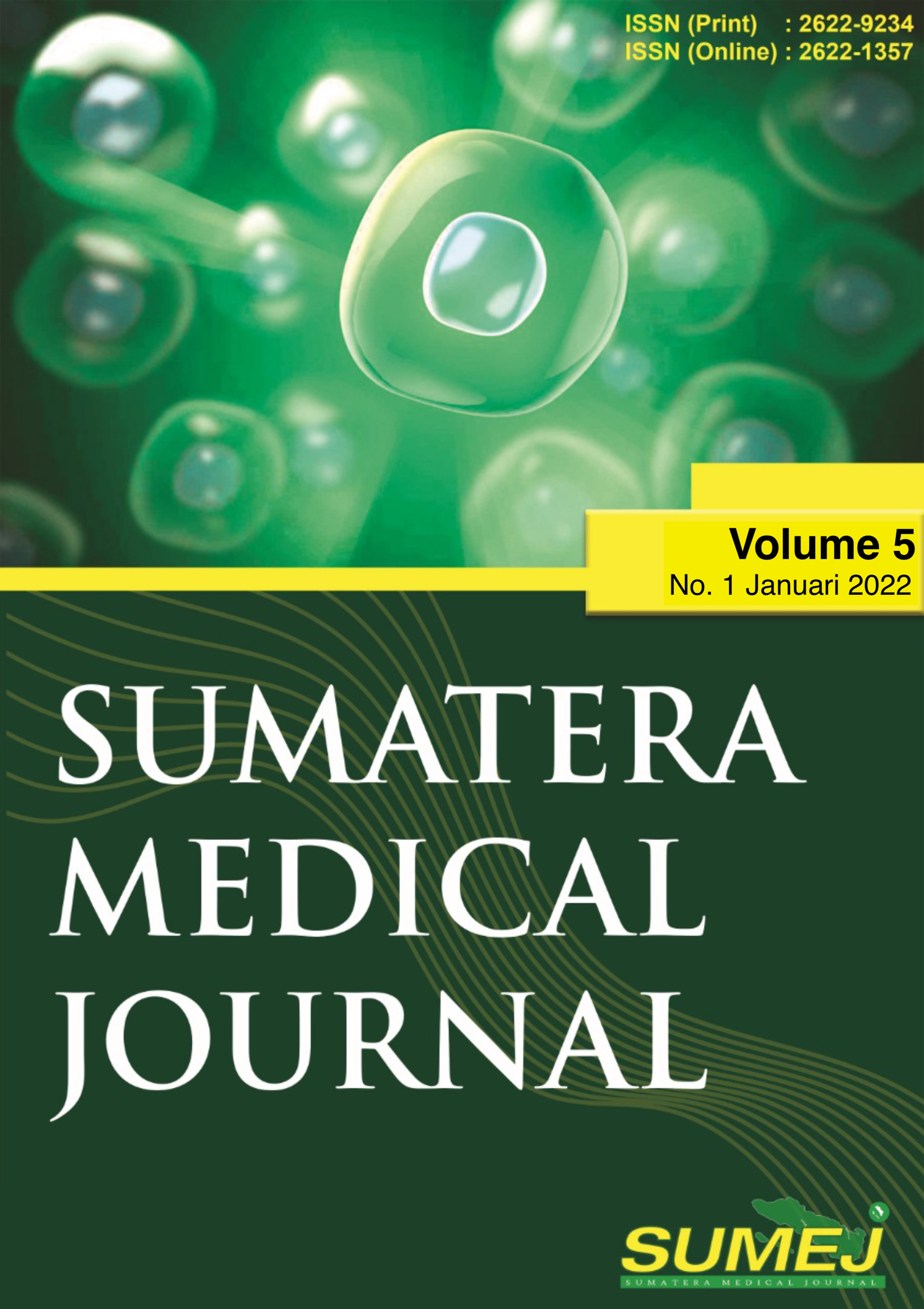A Case Report VP shunt in Non Communicating Hydrocephalus due to Intracerebral Hemorrhage
DOI:
https://doi.org/10.32734/sumej.v5i1.9383Keywords:
Intracerebral Hemorrhage, Hydrocephalus, Stroke, VP ShuntAbstract
Stroke is one of the top three cause of death and disability globally. Approximately, only 10% to 15% of first-ever stroke are intracerebral hemorrhages (ICHs), but the rates of disability and death are significantly higher. Hydrocephalus may occur in more than 50% of patients with intraventricular hemorrhage (IVH), which is secondary to ICH. Intraventricular hemorrhage (IVH), an accumulation of blood to ventricles that may be cause by extension of ICH, occurs in up to 50% of patients with primary ICH. Hydrocephalus itself may serves as a predictor of poor outcome after ICH.1,2,3
A 71 years old male came to the hospital with the complaint of loss of consciousness, difficulty in communicating, and weakness of extremities on the left side of the body since 12 hours ago. The complaint was preceded by headache that did not alleviate with medication since 1 day before admission and there was history of slurred speech. A head CT scan without contrast was done and the result showed an intracerebral hemorrhage and a suggestive obstructive hydrocephalus. The patient was diagnosed noncommunicating hydrocephalus due to spontaneous intracerebral haemorrhage (ICH) at the right thalamus with intraventricular haemorrhage due to suspect hypertension with differential diagnosis of cerebral amyloid angiopathy with emergency hypertension. The patient was advised to underwent an emergency VP shunt placement.
Implantation of a ventriculoperitoneal (VP) shunt is the most widely used treatment of hydrocephalus. Considered to be a major privonce of neurosurgery, it accounts for 70.000 hospital admission in the US. Even though, VP shunting of CSF reduces the morbidity and mortality of post-hemorrhagic. hydrocephalus, it is associated with potential complications requiring multiple surgical procedures, as well as shunt revision due to its failure during the patient’s lifetime.4
Downloads
References
Hu YZ, Wang JW, Luo BY. Epidemiological and clinical characteristics of 266 cases of intracerebral hemorrhage in Hangzhou, China. J Zhejiang Univ Sci B. 2013 Jun;14(6):496-504.
Hu R, Zhang C, Xia J, Ge H, Zhong J, Fang X, Zou Y, Lan C, Li L, Feng H. Long-term Outcomes and Risk Factors Related to Hydrocephalus After Intracerebral Hemorrhage. Transl Stroke Res. 2021 Feb;12(1):31-38.
Garton T, Keep RF, Wilkinson DA, Strahle JM, Hua Y, Garton HJ, Xi G. Intraventricular Hemorrhage: the Role of Blood Components in Secondary Injury and Hydrocephalus. Transl Stroke Res. 2016 Dec;7(6):447-451.
Reddy GK, Bollam P, Shi R, Guthikonda B, Nanda A. Management of adult hydrocephalus with ventriculoperitoneal shunts: long-term single-institution experience. Neurosurgery. 2011 Oct;69(4):774-80
Crandall KM, Rost NS, Sheth KN. Prognosis in intracerebral hemorrhage. Rev Neurol Dis. 2011;8(1-2):23-29.
Carhuapoma, J.R., Mayer, S.A., Hanley, D.F., 2009. In- tracerebral Hemorrhage. Cambridge University Press, New York, USA, p.1-16.
Strahle J, Garton HJ, Maher CO, Muraszko KM, Keep RF, Xi G. Mechanisms of hydrocephalus after neonatal and adult intraventricular hemorrhage. Transl Stroke Res. 2012;3(Suppl 1):25-38.
Staykov D, Bardutzky J, Huttner HB, Schwab S. Intraventricular fibrinolysis for intracerebral hemorrhage with severe ventricular involvement. Neurocrit Care. 2011;15:194–209.
Reddy GK. Ventriculoperitoneal shunt surgery and the incidence of shunt revision in adult patients with hemorrhage-related hydrocephalus. Clin Neurol Neurosurg. 2012;114(9):1211-1216.
Ziai WC, Carhuapoma JR. Intracerebral Hemorrhage. Continuum (Minneap Minn). 2018;24(6):1603-1622.
Druid H, et al. The Swedish cause of death register. Eur J Epidemiol. 2017;32(9):765–73
Hwang BY, Bruce SS, Appelboom G, Piazza MA, Carpenter AM, Gigante PR, et al. Evaluation of intraventricular hemorrhage assess- ment methods for predicting outcome following intracerebral hem- orrhage. J Neurosurg. 2012;116(1):185–92.
Hansen BM, Nilsson OG, Anderson H, Norrving B, Säveland H, Lindgren A. Long term (13 years) prognosis after primary intrace- rebral haemorrhage: a prospective population based study of long term mortality, prognostic factors and causes of death. J Neurol Neurosurg Psychiatry. 2013;84(10):1150–5.
Brouwers HB, Chang Y, Falcone GJ, Cai X, Ayres AM, Battey TW, et al. Predicting hematoma expansion after primary intracere- bral hemorrhage. JAMA Neurol. 2014;71(2):158–64.
Whitelaw A, Aquilina K. Management of posthaemorrhagic ven- tricular dilatation. Arch. Dis. Child. Fetal Neonatal Ed. 2011
Downloads
Published
How to Cite
Issue
Section
License
Copyright (c) 2022 Sumatera Medical Journal

This work is licensed under a Creative Commons Attribution-NonCommercial-NoDerivatives 4.0 International License.
The Authors submitting a manuscript do so on the understanding that if accepted for publication, copyright of the article shall be assigned to Sumatera Medical Journal (SUMEJ) and Faculty of Medicine as well as TALENTA Publisher Universitas Sumatera Utara as publisher of the journal.
Copyright encompasses exclusive rights to reproduce and deliver the article in all form and media. The reproduction of any part of this journal, its storage in databases and its transmission by any form or media, will be allowed only with a written permission from Sumatera Medical Journal (SUMEJ).
The Copyright Transfer Form can be downloaded here.
The copyright form should be signed originally and sent to the Editorial Office in the form of original mail or scanned document.











